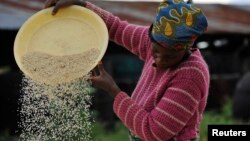YAOUNDE, CAMEROON —
Researchers are mapping out ways to increase rice production in Africa in order to combat hunger. That's a prime topic at the third African Rice Congress taking place this week in Cameroon.
Thirty million tons of rice are consumed in the continent and experts at the meeting say 60 percent of that is imported from Asian countries.
They estimate Africa spends $5 billion on rice imports yearly, yet there are still rice shortages on a continent with more than 850 million hungry and malnourished people, according to the U.N. Food and Agriculture Organization (FAO).
Africa rice production dropped drastically in some countries after the economic crisis of the 1990s, says Samantana Mark, director general of Cameroon's rice production company, SEMRY.
“With the advent of the economic crisis, states stopped investments in the transformation and marketing of rice," Mark said. "That is why Cameroonians were not visible in the rice markets, and Nigerians came in to buy and process the rice in their countries and supply it right to Sudan.”
Climate change, extreme temperatures and plant disease constitute a major impediment to rice cultivation especially in sub-Saharan African countries.
But some researchers, like the Nigerian-born Adekoya Madinat with the Shanghai Academy of Agricultural Sciences, say they have come up with water-saving varieties.
"With this research we try to see how much water exactly is needed for rice production and try to see which genes are actually recruited during the event of droughts," Madinat said. "So these genes can be used to develop drought-resistant varieties that can be planted with minimal water and we still have very good yields and food security."
Marie Noel Njon Njock, a molecular biologist from Cameroon's Institute of Agricultural Research, presented research findings she says could increase rice production if applied.
“Molecular biology has a very big potential because you can know the real diversity since we work at the DNA level," Njock said. "So our goal is really to be able to feed the population using rice based products.”
The Congress participants called for the mechanization of African agriculture, which Cameroonian-born Dorothy Mallah says is a sure way of making rice available whenever it is needed.
“If we mechanize the rice sector only with small small machines, then rice production will triple and we will become rice exporters instead of rice importers,” Mallah said.
Investing in rice production requires huge amounts of money. FAO's Robert Guei says that should be an immediate priority for African governments seeking to eliminate hunger and poverty.
“African governments have to support small companies," Guei said. "These people have to be encouraged so governments have to come out with good policies whereby these companies are subsidized. Help them to have credits to banks and loans so that they can produce these varieties of rice and distribute and this is what FAO is doing now, talking to governments to set up policies.”
Experts say that currently, African countries produce about 12 million tons of rice per year.
Thirty million tons of rice are consumed in the continent and experts at the meeting say 60 percent of that is imported from Asian countries.
They estimate Africa spends $5 billion on rice imports yearly, yet there are still rice shortages on a continent with more than 850 million hungry and malnourished people, according to the U.N. Food and Agriculture Organization (FAO).
Africa rice production dropped drastically in some countries after the economic crisis of the 1990s, says Samantana Mark, director general of Cameroon's rice production company, SEMRY.
“With the advent of the economic crisis, states stopped investments in the transformation and marketing of rice," Mark said. "That is why Cameroonians were not visible in the rice markets, and Nigerians came in to buy and process the rice in their countries and supply it right to Sudan.”
Climate change, extreme temperatures and plant disease constitute a major impediment to rice cultivation especially in sub-Saharan African countries.
But some researchers, like the Nigerian-born Adekoya Madinat with the Shanghai Academy of Agricultural Sciences, say they have come up with water-saving varieties.
"With this research we try to see how much water exactly is needed for rice production and try to see which genes are actually recruited during the event of droughts," Madinat said. "So these genes can be used to develop drought-resistant varieties that can be planted with minimal water and we still have very good yields and food security."
Marie Noel Njon Njock, a molecular biologist from Cameroon's Institute of Agricultural Research, presented research findings she says could increase rice production if applied.
“Molecular biology has a very big potential because you can know the real diversity since we work at the DNA level," Njock said. "So our goal is really to be able to feed the population using rice based products.”
The Congress participants called for the mechanization of African agriculture, which Cameroonian-born Dorothy Mallah says is a sure way of making rice available whenever it is needed.
“If we mechanize the rice sector only with small small machines, then rice production will triple and we will become rice exporters instead of rice importers,” Mallah said.
Investing in rice production requires huge amounts of money. FAO's Robert Guei says that should be an immediate priority for African governments seeking to eliminate hunger and poverty.
“African governments have to support small companies," Guei said. "These people have to be encouraged so governments have to come out with good policies whereby these companies are subsidized. Help them to have credits to banks and loans so that they can produce these varieties of rice and distribute and this is what FAO is doing now, talking to governments to set up policies.”
Experts say that currently, African countries produce about 12 million tons of rice per year.








